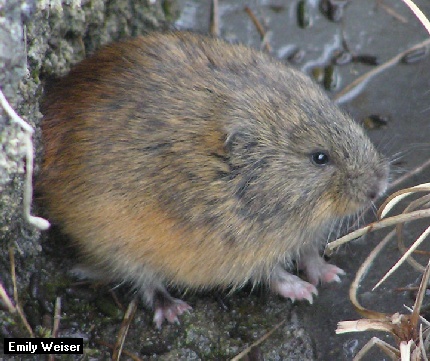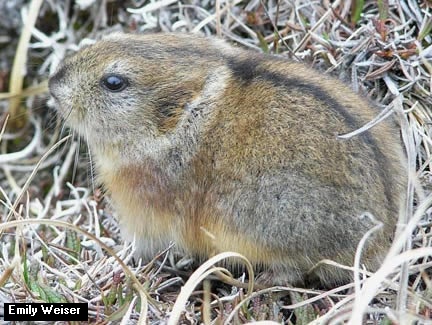

HABITAT and HOMESLemmings live in the treeless areas of Northern Canada and in Alaska. (map)
In the winter lemmings live in burrows in the snow.
They make many snow tunnels.
They are safe from the cold and wind.
Their underground burrows have rest areas, bathrooms and nesting rooms.
Lemmings make nests out of grasses, feathers and musk ox wool.
APPEARANCELemmings are small short-tailed rodents. They look like fat furry hamsters. They have strong legs and claws for digging. Thick fur helps to keep them warm.There are collared lemmings and brown lemmings. Collared lemmings' coats turn from brown to white for the winter.  FOODLemmings eat plants, roots, berries and lichens. They gather seeds to eat in the wintertime.ENEMIESLemmings are eaten by many animals. The ermine (weasel), Arctic fox , Snowy Owl, wolf and wolverine are just some of their enemies.Arctic foxes can sniff out lemmings in their burrows under the snow. Ermine (weasels) can fit down the lemmings' burrows. They chase the lemmings into their burrows and kill them by biting their necks. When there are fewer lemmings, there are fewer predators (animals that hunt lemmings for food). PROTECTIONLemmings run quickly and hide in their tunnels under the snow or underground.THE YOUNGFemales give birth to up to eight babies every five weeks. The high number of lemmings helps to provide food for many animals.ADAPTATIONSWhen there are too many lemmings in one area and not enough to eat, they migrate to find food. Many drown by running into the rivers and lakes.IMPORTANT FACTSThe number of young that a Snowy Owl has depends on whether there are alot of lemmings or not.Every three or four years the number of lemmings decreases. If there are too many lemmings there would not be enough food for all of them. Then many lemmings would starve. The predators would also starve. 
brown lemming & collared lemming - Emily Weiser, Mammals of the North Slope (Alaska) ; used with permission jgiannet@hotmail.com (2001) updated August 2011 |